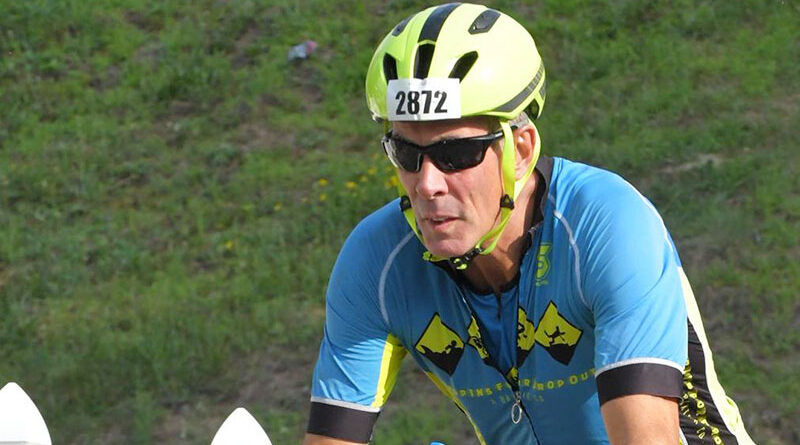Not Slowing Down
Triathletes enjoy the challenge, the competition … and the camaraderie
By John Addyman
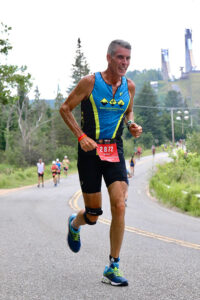
First, the water. It’s the crack of dawn and you’re going to swim 1.5 kilometers, with a lot of other people.
Then, the bike. Out of the water, put on shoes for the 40-kilometer ride. Get your hydration and nutrition packs together. Pass people if you can. Drink and eat along the way.
Finally, the run.
Off the bike, change to running shoes. Ten kilometers of road work ahead of you, with legs that feel like jelly to start.
And the finish.
Delight. Relief. Deep satisfaction. Wondering what’s going to hurt the next day. And already looking forward to the next triathlon.
They say if you can run and bike and swim, you can do a triathlon. That’s like saying if you can count, you can run a bank. Or if you can smile, you can be a movie star.
A triathlon is an exercise in will, stamina and foresight. To get up with the birds every morning to complete a run or a swim takes determination and discipline. To train like you never have before is the minimum.
In the end, the rewards are spiritual, physical, emotional and social.
Becoming Triathletes
“I was a long-distance runner,” said Mike McDermott, 58, of Rochester, a senior strategic account manager for Trane Technologies. “I came to running at the age of 40.”
At 6-4, running wasn’t his first love. Basketball and baseball were, through and after RIT.
“I played a lot of competitive basketball and baseball after college, including travel softball. At 40, I realized I couldn’t continue to play basketball and still get up and go to work on Monday morning. My knees hurt; I had a lot of sprained ankles. I just generally ached. For fitness, just general fitness, I started running. My wife, Brenda, had done the Boilermaker, a 15K race in Utica with some of her girlfriends. I said to myself, ‘I think I can do that.’ So I went out and ran a 15K and afterwards said, ‘Oh my God! I’m out of shape!’” he said. “That’s how I came to running, even though I thought I was in shape. At the age of 40, I’d always run, jogged here and there, but no races, nothing like that.”
Now he’s a triathlete.
Pam Cooper-Vince, 67, of Rochester, started running at Fordham University when she was pursuing her bachelor’s degree in philosophy.
She met her husband, Roger Vince, on a drive to a college-sponsored silent prayer retreat.
Vince was a year ahead of her in school. He graduated from Fordham in 1974 and went to Northwestern for a PhD in biology, then to UConn Medical School in 1977.
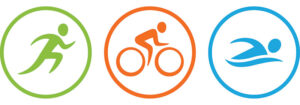 Cooper-Vince went to Fordham Law School and while studying for the bar, would run six miles most mornings with a friend and two lawyers.
Cooper-Vince went to Fordham Law School and while studying for the bar, would run six miles most mornings with a friend and two lawyers.
Roger and Pam married in 1978. She practiced law for the US Small Business Administration and a small private firm in Hartford, Connecticut.
“Meantime, Roger was out in Chicago and he had started running,” she said. “We actually did a 20K, not a half-marathon, back in 1978 in New Haven, the first annual.
“In 1982 I started my own practice and very promptly was pregnant with our first child. I started my own practice out of the house, but totally closed it up in 1987 when Roger accepted a cardiology job in Canandaigua and we moved here. I never got back into practicing law.”
What she did do is become a pastoral associate, earning a master’s degree in divinity at Colgate Rochester Crozer Divinity School.
“I worked for churches for a while. My youngest was in high school. I was very busy with kids. I worked at churches on the west side of the city and St. Dominic’s in Shortsville,” she said. “It was pretty good. But being a woman, you’re only able to go so far. Eventually I started getting very busy, moved my parents up from Florida because they needed help. Left that job with the church in 2006 and haven’t really worked fulltime since.”
Cooper-Vince graduated from running long distances to the biking, running and swimming of triathlon.
Her last full year of competition was 2019; COVID-19 took care of 2020. In that 2019 season, Cooper-Vince was first in her age class at the Rochester Autumn Classic Formula I Duathlon at Mendon Park — a two-mile run, 10-mile bike ride, another two-mile run and another 10-mile biking, then a finishing two-mile run. She did all that in 2 hours, 26 minutes and 6 seconds (2:26.06).
In August of 2019, she finished 13th in the USA Triathlon Age Group Nationals in Cleveland in 2:52.31 — a 1.5-kilometer swim, 40K bike ride and finishing 10K run. Six days before that she took third in her group at the Cayuga Lake Sprint Triathlon (.75K swim, 14-mile bike, 5K run) in 1:46.53. In May, she was second at the Escape the Cape Intermediate Triathlon, which features a mile swim that starts by jumping off the back of the Cape May-Lewes Ferry, a 12-mile bike tour and finishing five-mile run.
She ran the 2017 Ironman Maryland (2.4-mile swim, 112-mile bike, 26-mile run) in Cambridge.
“I finished…not in the daylight. My goal was to finish on two feet before they closed the course with no one saying to me, ‘Ma’am, do you need medical assistance?’ I finished with my goals met. I started at 7 a.m., 15 hours later there are people lining the finish at 10:30 at night. People banging on the boards lining the finish, cheering you on. It’s fantastic. At the end, you’re just stoked. It’s fun.”
No Clue About a Wetsuit
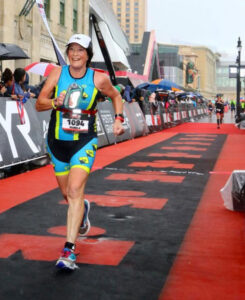
McDermott had a pivotal year in 2008. Although he admitted, “I’m not a mileage guy,” he ran marathons in 2007 and qualified for the 2008 Boston Marathon, fulfilling a dream.
“I set my sights to do Boston. I was training in the winter, heavy training. I remember having to get in a 20-mile run before that race, when we’d had a bunch of snow,” he said. “I ran the outer loop at MCC, which is almost exactly two miles. Sometime after my first or second loop, I picked up my own personal snow plow — It was a Saturday morning and the plow guy kept plowing the circle for me. That’s a unique memory of training for Boston.
“Boston was a blast, both my mom and dad were from there, so a lot of family and friends were there. It was a tough race. The hills are tough. I struggled. I ran maybe a 3:25 — middle of the pack, nothing great. I really soaked it in. It’s an event, or a spectacle. You feel like a rock star in the race. When you’re running a local race, there are miles on end you won’t see anybody. At Boston, that course is lined. I just enjoyed it. My time did qualify me to run Boston again. My goal was to enjoy the race and I did. That was a great event. I got to run alongside Dick Hoyt (who pushed his wheelchair-bound son) who just passed away, alongside him and his son coming down Boylston Street to the finish, for a minute or two. That was a moment.”
He wanted to run the New York Marathon, “but I just kept getting injured. Plantar fasciitis. Knee scoped. Double sports hernia. Shingles. I began to think that marathoning was not to my long-term benefit. I decided I needed to do more cross training,” he said.
So, he bought a bike.
“I decided I should also swim because then I could do triathlons. I grew up in New Jersey and spent my summers in the ocean. I got connected with Rochester Area Triathletes and saw they had group workouts,” he said. “I went up one Sunday morning to Durand Park and met a bunch of folks and got in the water. And, this I remember like it was yesterday: everybody was putting on wetsuits. I had no clue about a wetsuit. I was just in a pair of gym shots.
“Someone said to me, ‘No wetsuit?’ I said, ‘No.’ They said, ‘You’re brave.’
“No, probably dumb. We get into the water; we’re going to swim half a mile to a buoy, parallel to the shore. That was the moment I realized I had no idea how to swim. I did an elementary backstroke for a half-mile. It was shallow enough that I walked a little. I completed it and luckily enough the guy who was lifeguarding us stuck around to watch me because everyone else was off doing the bike and run. I said to him, ‘I am going to need some help with this swimming thing.’”
McDermott got in touch with well-known local triathlete coach Mike Baxter.
“My wife and I do this as team. She enjoys — ‘puts up with’ — these events. In my view, triathlon can be a very selfish sport. It’s expensive and it takes a lot of time from your family.”
Mike McDermott, 58, of Rochester
“He’s the one who taught me how to swim, starting off with a doggy paddle, learning how to breathe in the water, just like my kids did at the town pool,” McDermott said. “It was a challenge to say the least. I thought I was in great aerobic shape, but there’s a difference between being in running shape and swimming shape. That I found out quickly. It probably took me a year and a half. I started with Mike in the fall and It took me three winter sessions with him and the first session of open water swimming with him before I signed up for my first triathlon.”
Baxter is also instrumental in DIDO — Drop Ins for Drop Outs (Facebook) — a social group of athletes who actively support each other in attaining their goals, hosting swims, cycle practice and running.
In 2018, McDermott finished ninth in his age group of 31 competitors in the Geneva Musselman Triathlon and he’d made another transition.
“My wife and I do this as team. She enjoys — ‘puts up with’ — these events. In my view, triathlon can be a very selfish sport. It’s expensive and it takes a lot of time from your family. Brenda is super about it. She has accompanied me on almost every one of these little things. We did an AirBnB in a little trailer right on the lake in Geneva,” he said. “That was nice. We usually try to find a restaurant and a microbrewery wherever we go the night before. I like to do well in triathlons but I’m not so serious about nutrition, I just eat more. And I still enjoy a glass of wine and a beer.”
Always someone who looks for the next level, McDermott wanted to do some ironman competition, double what’s expected in a triathlon, starting with a 2.4-mile swim, then a 112-mile bike ride and 26.2-mile marathon run. He thought he had realistic goals for his first, the Lake Placid Ironman in 2019.
“I had a goal: finish the swim; finish the race; finish before sundown, which if you can finish in daylight, that’s something a lot of people go for. And in my mind, I really wanted to finish in less than 13 hours—I met all the goals except finishing in less than 13 hours. It was just such a great weekend from a family perspective,” he said. “It just was the most fun. Race day was great. I just enjoyed it. Swim went well, but bike is a tough, tough course. Two loops, total elevation gain is 6,000 feet. Beautiful—the scenery is beautiful—riding along Ausable River.
“The bike took me 6.5 hours: I had a mechanical issue, I had to fix my tire. Then I had another mechanical issue—my water bottle cage was flapping around. It didn’t matter. You’re in the moment. That’s ironman, you just overcome. I don’t know any ironman whose race goes the way they planned. At the run, my goal was to try to run the first 13 miles and see where I was. I got through 6.5 miles and my feet were killing me, I had blisters on the balls of my feet. I think it happened on the bike. I walked the last 20 miles. That’s where my long legs came in handy, I was literally walking faster than some people were running.
“My family saw me walking. I told them, ‘Don’t worry, I’m going to finish, I’ll see you in a couple of hours.’ I finished right before dark. That course is inspiring. You bike past the ski jump and the bobsled, and Whiteface Mountain where they did all the ski events and you finish in the speed-skating oval right in front of the high school and the crowd is so phenomenal. Another thing I regret; my family was all at the finish line wanting me to high-five me, but I didn’t hear them or see them. I was in my own little world: 13 hours and 47 minutes does that to you. I did run the last half-lap around the oval.”
Triathlete with different skills
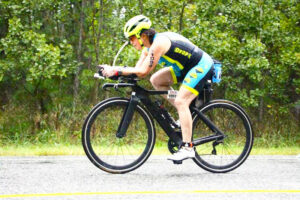
Cooper-Vince stopped running once her family began to grow. But one morning, she decided to run with her daughter, who was in high school.
“I think I got less than a half-mile, just down the road here. I felt like I was about to die and I probably looked like I had already died. I said to myself, ‘Oh my gosh, this is terrible!’ So I started going to the Y and using the weights in the exercise room. After doing that for about six months to a year, I decided to start running again. I ran around my neighborhood, about 1.4 miles, twice. And at 8 a.m. in the morning I called my now-college student daughter up and said, ‘I just ran 2.5 miles.’ She said, ‘That’s really wonderful, mom. Could you have waited a little later in the day to let me know?’” she said.
“Then I started doing more running. We did a couple of 5k races. The first triathlon was the Pittsford Tri, probably in 2006 or 2007. Problem was, I didn’t bicycle as a kid. I’d bicycled in college, down to Fordham and back from my parents’ house, which was maybe 10 miles. I didn’t know if I could bicycle 13 miles for a triathlon. A friend set me up with a group of her friends who cycled and after we’d been out for a while, told me we’d covered 13 miles, so I knew I could do it,” she said.
While McDermott has the long legs for running and biking, he had to learn to swim to compete. Cooper-Vince started out as a strong swimmer with years as a runner, too. For her, the bicycle was the challenge.
“Swimming is my strongest thing,” she said. “Then the running then the bicycling. Unfortunately, the largest part of triathlon is bicycling. “Mike is pretty good, awesome on the bicycle. He’s got long legs, long feet. His cycling is far better than mine. He’s also a guy and younger than me.”
Even with COVID-19 changing everything last year, Cooper-Vince kept training. “The favorite place for me, for cycling, was along the canal, because I don’t have to worry about cars. But that was an issue because there were too many people without masks, running without masks,” she said. “I kind of varied where I do a lot of cycling. I do a lot in Mendon Ponds Park, which is a great place for cycling. Now I’m a little more comfortable after being vaccinated and I won’t freak out if somebody comes by me. For some reason, people were operating on the canal like they didn’t need a mask, even though they come within two feet of you.
“We were scheduled for Triathlon USA Age Group Nationals in 2020 and World Championships in 2020. The nationals are scheduled to take place in August; the world championships are scheduled for Edmonton Alberta, but the Canadian border hasn’t been open since March.”
McDermott will also compete in the nationals, but his ironman days are done.
“On Nov. 22, 2019, I came home from the gym and had a mini-stroke. My wife said I slurred a couple of words and she rushed me to Strong,” he said.
He has a clot in his left carotid artery. Doctors told him the clot is not going to go away, “but you can go on and live your life.”
“It took me until January or February to get back to running. It’s been a little bit of a blessing because there has been no racing,” he said. “I picked up my training, but not with any races in mind. I am qualified for the Nationals.
“My wife feels training was the cause of the mini-stroke,” he said, sitting in his kitchen, with wife Brenda six feet away, folding clothes. “I promised my wife I’m done doing ironman.”
His wife nods from the other side of the kitchen.
“I will do races from an enjoyment standpoint. I love the social aspect. I trained with RATs (Rochesterareatriathletes.com) and DINOS and the people are just phenomenal, super encouraging, no judgment,” he continued. “I love the social aspects of the clubs and the races. When I go out to nationals in Milwaukee there will be people from RATs there and DIDOs and we’ll set up a tent and do social things.”
Does Brenda worry about him?
“Of course,” she laughs. “I worry about him every day. He’s not allowed to do any more ironman, but I don’t know how I can not let him do any more races because that’s what he’s passionate about.”
“I’ll keep doing this as long as my body lets me,” McDermott said. “You don’t have to be in shape, anybody can do triathlon. Reach out to DIDOs or RATS and just come out. Every town has a triathlete group and they’re all the same — super supportive — no judgment. None, not at all. The amount of knowledge you get – everyone wants to share, everyone wants the sport to grow. It’s a great way to get in shape, stay in shape and the social aspect — both training and racing — is phenomenal. DIDOs has a regular calendar of events; RATS has a Sunday morning swim-bike-run at Durand, or Mendon Park, where you can run-bike-run during the week—bring a beer for afterwards. All kinds of opportunities to just come out and enjoy it. While I tend to do a lot of my hard training alone because my schedule is flexible and I can do what I want, it’s a great sport and a great way to stay active and be social and go some neat places and support local communities.”
What’s Next?
Michael McDermott and Pam Cooper-Vince have a packed schedule in the coming months. McDermott is training for USA Triathlon Age Group National in Milwaukee, Aug. 7, and will participate in the Rochester Triathlon Sprint Event, Aug. 21. Cooper-Vince will also participate in those two races. In addition, she will compete in the half iron distance in the Ironman 70.3 Maine to be held in Old Orchard Beach, Maine, Aug. 29, and the full-iron distance in the Maryland Ironman to be held in Cambridge, Maryland, Sept. 18.

